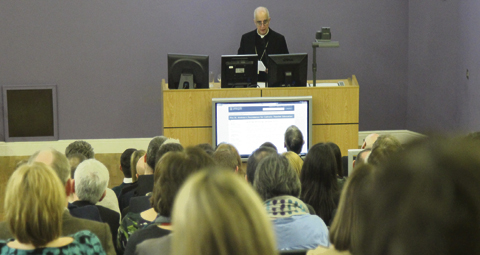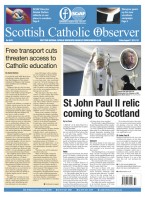February 20 | ![]() 0 COMMENTS
0 COMMENTS ![]() print
print

Strong in Faith: Jesus Christ became man, not a code of zeroes, ones
After listening to Archbishop Fisichella on digital culture, AIDAN MICHAEL COOK flags up that The Real Presence is found in the Body and Blood, not in the pixels of a TV or computer screen
Delivering the Cardinal Winning Lecture at Glasgow University last weekend, Archbishop Fisichella, president of the Pontifical Council for Promoting New Evangelisation suggested that we have not sufficiently reflected on the digital age and the opportunities and challenges it brings to evangelisation. One problem he noted was that ‘we still have the idea that the internet is an instrument, when in reality I think it has become a culture.’
“It is no longer enough simply to make use of these devices; we must rather find a way to evangelise a culture formed by these devices,” he said. Ultimately, the problem comes down to this: how can we use such remote means to transmit a faith so rooted in the flesh and blood reality of the Incarnation to a digital culture that encourages detachment?
I think the issue has even crept into our Liturgy with the increasing use of microphones and cameras to enhance the human experience. It is well intentioned, but the problem is that watching or hearing something transmitted electronically is not the same as experiencing the actual event. A clear example is Eucharistic adoration: what does it mean to watch Exposition on a screen? The Real Presence is found in the Body and Blood, not in the pixels of a TV screen.
Watching the consecration at Mass on a TV screen while the real thing takes place just metres away, even if blocked from view by a pillar, in fact isolates the viewer from reality: what is intended to bring worshippers closer to the events of the altar actually detaches them, taking them much further away. Even a microphone and speakers, for all their benefits, disembody the voice to some extent. In this way, true encounter is too often hindered by the impersonality of the digital world.
As Archbishop Fisichella put it ‘Christianity has always been the communication of an event and an experience; how can we render faith intelligible to one who lives in the web?’ He suggested that part of the answer at least must be ‘to help our brothers and sisters understand that Jesus Christ is the key to deciphering life’—Christ is the decoder Who turns the scrambled signals of life into a clear, meaningful message.
But how do we enable even this decoded message to be understood? The answer, I believe, lies beyond the digital. The archbishop noted some of the fundamental concepts of Christian life that are incomprehensible to modern culture: ‘renunciation, virtue, interior life, contemplation, adoration, the cross, resurrection, the imitation of Christ, silence, spiritual direction, eternal life…’
We need to bring these concepts to the digital world, or, rather, to bring the digital world out of itself in order to meet these foreign concepts.
The digital world is neither spiritual nor material, but instead is caught in no man’s land. The task of digital evangelisation must be not only to communicate the truth of the Gospel and the relevance of its message, but also to draw people out of the digital world into a real encounter, and allow them to lift their eyes, minds and hearts to higher things.
Archbishop Fisichella spoke of the Gospel needing to shake people out of their stupor and indifference. This is even more true of the digital world, which can so easily suck us in and ensnare us in the web. We need only think of how often we check our phones and social media instead of profiting from the company of those around us, or stay up well into the night clicking one link after another, or watching mindless videos on YouTube.
Ironically, the ‘fear of missing out’ can so easily cause us to miss out on what really matters.
The digital world has brought some
wonderful opportunities, but we should always remember that Christ became man: Flesh and blood, not zeroes and ones. Our evangelisation of digital culture must always point beyond, drawing people into an encounter—a real face-to-face encounter—with both God and neighbour.
—What do you think about this article and subject? Have your say at https://www.facebook.com/scostronginfaith, where you can also suggest topics for discussion
—Pic: Robert Wilson











